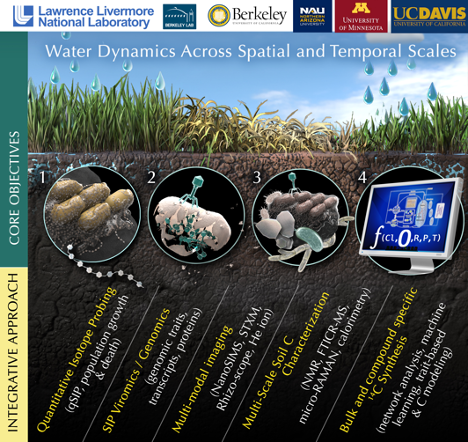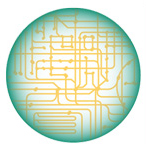Science Focus Area: Lawrence Livermore National Laboratory
- Principal Investigator: Jennifer Pett-Ridge1
- SFA Technical Co-Manager: Steve Blazewicz1
- SFA Project Manager: Katerina Estera-Molina1
- Co-Investigators: Jeff Kimbrel1, Karis McFarlane1, Peter Weber1, Rhona Stuart1, Keith Morrison1, Gary Trubl1, Eric Slessarev1, Noah Sokol1, Mavrik Zavarin1, Mary Firestone2, Jill Banfield2, Rohan Sachdeva2, Bruce Hungate3, Paul Dijkstra3, Ben Koch3, Egbert Schwartz3, Eoin Brodie4, Peter Nico4, Jinyun Tang4, Joanne Emerson5, Peter Kennedy6, Ljiljana Paša-Tolic7
- Participating Institutions:1Lawrence Livermore National Laboratory, 2University of California–Berkeley, 3Northern Arizona University, 4Lawrence Berkeley National Laboratory, 5University of California–Davis, 6University of Minnesota, 7Pacific Northwest National Laboratory
- Collaborations: University of California–Merced (Leila Wahab), University of Pennsylvania (Alain Plante, Maura Slocum), University of Indiana (Rich Phillips, Ashley Lang), DOE Systems Biology Knowledgebase (KBase), Environmental and Molecular Sciences Laboratory (EMSL), Joint Genome Institute (JGI)
- Field Sites: Hopland Research and Extension Center, Angelo Coast Range Reserve, Sedgwick Reserve, Luquillo Experimental Forest
- Project Website: sc-programs.llnl.gov/biological-and-environmental-research-at-llnl/soil-microbiome
- KBase Collaboration: Microbes Persist: Towards Quantitative Theory-Based Predictions of Soil Microbial Fitness, Interaction and Function in KBase
Summary

Microbes Persist Science Focus Area (SFA) Objectives. This SFA explores: (1) effects of water regimes on ecophysiology of soil microbiomes, (2) distinct modes of microbial mortality, (3) role of microbe-mineral interactions in soil organic matter persistence, and (4) data synthesis and modeling. The SFA seeks to gain a foundational and predictive understanding of the interacting biological, biogeochemical, and physical factors that control soil carbon turnover and persistence. Because of the vast complexity of soils, the multi-institutional team includes experts in soil microbiology, ecophysiology and biogeochemistry, metagenomics and viral ecology, organic matter–mineral chemistry, isotope and compound-specific mass spectrometry, and multiscale modeling. [Courtesy Victor O. Leshyk, Center for Ecosystem Science and Society, Northern Arizona University]
The central hypothesis of the Microbes Persist Science Focus Area (SFA) is that microbial cellular chemistry, functional potential, and ecophysiology fundamentally shape soil C persistence. The SFA team is testing this concept by characterizing the capabilities of the “active” microbiome and virome, using stable isotope-informed approaches to scale from metagenomes and viromes to computational models that integrate traits at the system scale.
In semi-arid systems, rainfall and soil water act as “master controllers” of microbial transformations, interactions, and SOM stabilization processes. With Earth system models projecting major changes in precipitation in many regions, the SFA’s ultimate goal is to determine how microbial ecophysiology, population dynamics, and microbe-mineral interactions regulate the persistence of soil microbial residues under changing moisture regimes.
Specific objectives include:
- Apply stable isotope probing (SIP) metagenomics to define how changing water regimes and soil depth shape active microbiome populations and expression of ecophysiological traits that affect the fate of microbial and plant C.
- Quantify soil microbiome mechanisms of mortality (especially viral lysis, bacterial predators, and water stress) and their contribution to C turnover and the biochemistry of microbial and viral residues.
- Measure how the soil microbiome and its products interact with contrasting mineral assemblages to control soil C persistence.
- Synthesize and quantify the mechanistic relationships between soil microbiomes and the fate of C in soil.
